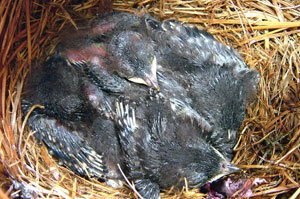Linda Moore of Georgia captured this incredible but disturbing footage on a nest cam at about 8 p.m. on 6/22/07. It shows what appears to be a House Wren removing three out of four newborn (1-2 day old) Eastern Bluebird chicks from a nestbox. Fortunately Moore was watching the video feed and immediately went outside with her husband and their dogs and a flashlight. They found all four babies on the ground, flung in every direction. They returned the babies to the nest. The House Wren? returned the subsequent night and again removed the babies. The Moores replaced them, and took steps to protect the young until they were too old to be removed (usually more than 4-5 days). The young survived, only because the Moores witnessed the attack.




Note how fast the attack occurred. This video – unedited, happening in real time – is only 51 seconds long, and three of the babies are removed in less than 20 seconds. Bluebird parents must leave the nest periodically to get food for the hatchlings, and House Wrens are very quick. These unsuspecting hatchlings, whose eyes will not open until 8-11 days after hatching, hear the noise, think it is a parent, and gape, begging for food. The third baby that was removed in the video was only 3-4 hours old. In the second attack, Moore reported that the House Wren grabbed onto the edge of a baby’s gaping mouth, pulled it through the hole, lost its grip and then grabbed it again and threw it out of the box. Another nestling was grabbed under its wing. Some folks did not think that House Wrens were common in this part of GA, and the BBS Map shows low populations. However, the Moores did find a House Wren nest in a neighbor’s box, about 400 feet away from this box.
Unlike House Sparrows, House Wrens are native birds, and are protected under the Migratory Bird Treaty Act. However, there are some options to prevent them from using a nestbox or to deter them from attacking other active nests. See House Wren Deterrence. Carolina Wrens (with a bold white eyeline) are not known to attack other birds’ nests.
I believe that nest cams (tiny cameras, often infrared, placed inside a nestbox) will bring our understanding of cavity nesters and their predators to a whole new level. Also, if the Moores had not witnessed the attack, they would have come out to an empty nestbox the next day. Though the babies were tossed onto the ground, another predator might have come by afterwards to take them, so there would not have been much evidence unless sticks (from a House Wren nest) showed up in the box afterwards.
Note that the intro photo is not Linda’s nestbox – it’s one of mine, where I caught a House Wren on my birdcam dismantling an active Tree Swallow nest.
More Information:
- Deterring House Wrens
- House Wren Biology
- Another perspective on House Wrens
- House Wren Attack on eggs (video)
- Suspected House Wren Attack on eggs (photo)
- Predator ID and Solutions
- House Wren nests, eggs and young – photos
- Nest cams
- Recognizing a HOUSE SPARROW attack
Video archives (Some are no longer live, sorry!)
- The Story of the Titmouse – Paul and Austin Murray
- Bluebird Food action – John Beaudette of Canada
- House Wren Attacking Eggs – Bet Zimmerman
- House Sparrow attacks another bird inside a nestbox – Tony Carita
- Hissing Titmouse – Bet Zimmerman
- Also see Nest Cam webpage (Sialis)
- House Wren attacks bluebird nestlings – Linda Moore
- Bumblebees in EABL nestbox – Bet Zimmerman
- Mouse House – Bet Zimmerman
- Flying Squirrel eating – Joe Chapuis, WebVideoZone.com
- Starling Attacks Purple Martins – Simon of purplemartin.tv
- Flying Squirrel peeks out of nestbox – Bet Zimmerman
- Nuthatch Roosts in Gilwood Nestbox claimed by EABL – Bet Zimmerman
- Bluebird Lays an Egg – Bet Zimmerman (with captions)
- Helpers – Fledglings feeding nestlings – Kenn
- House Wren divebombs monitor – Jeff Hansen
- Oak Titmouse assists egg hatching – Sue Flynn, Oregon
Somewhere over the rainbow
Bluebirds fly.
– from “Somewhere Over the Rainbow,” lyrics by E.Y. Harburg
